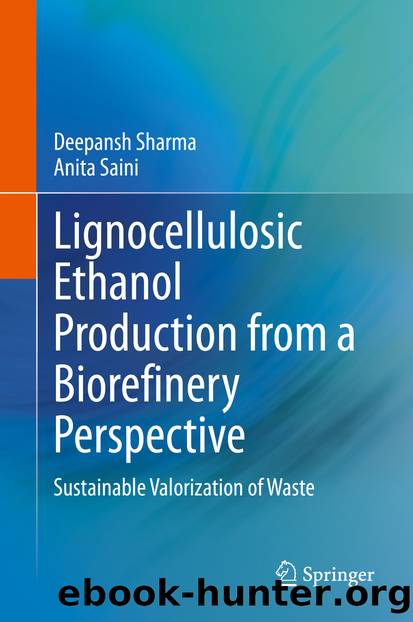Lignocellulosic Ethanol Production from a Biorefinery Perspective by Deepansh Sharma & Anita Saini

Author:Deepansh Sharma & Anita Saini
Language: eng
Format: epub
ISBN: 9789811545733
Publisher: Springer Singapore
The enzymes of cellulase complex vary in their substrate specificity, site of action, and mechanism of cellulose depolymerization. The cellulases enzymes are adsorbed and desorbed cyclically during the hydrolysis process (Taherzadeh and Karimi 2007; Quiroz-Castañeda and Folch-Mallol 2013). The endoglucanases act inside cellulose chains at random sites and release oligosaccharides (or dextrans) of variable lengths creating new chain ends (El-Naggar et al. 2014). These enzymes prefer amorphous (loosely packed) regions of the cellulose (Taherzadeh and Karimi 2007). The exoglucanases act at reducing and non-reducing ends of cellulose molecules and release cellobiose or glucose units as the main hydrolysis product (Quiroz-Castañeda and Folch-Mallol 2013; El-Naggar et al. 2014). CBHI exoglucanases and CBHII cellobiohydrolases cleave the glycosidic bonds at reducing and non-reducing ends, respectively (Quiroz-Castañeda and Folch-Mallol 2013; Volynets et al. 2017). The exoglucanases show a high degree of processivity, prefer attacking the crystalline regions of the cellulose, and make up to 40–70% of the total cellulases (El-Naggar et al. 2014). β-glucosidases enzymes are active at the last stage of hydrolysis catalyzing the cleavage of cellobiose units to release glucose monomers. The comprehensive hydrolysis of cellulose requires synergistic action of complete enzymes of the complex (Fig. 4.4). Thus, enzymes exhibit synergy between endoglucanases and exoglucanases (endo–exo synergy), the synergy between exoglucanases acting on the reducing and non-reducing ends (exo-exo synergy), the synergy between cellobiohydrolases and β-glucosidases role. Also, the interactions amid catalytic sites and carbohydrate-binding domains of cellulase enzymes play a crucial role (Lynd et al. 2002; Taherzadeh and Karimi 2007; Quiroz-Castañeda and Folch-Mallol 2013). The cellulolysis is regulated thoroughly by negative regulation of endocellulases and exocellulases by end-product inhibition. Therefore, it is generally advantageous to remove the end products to facilitate complete hydrolysis of cellulose and increase the sugar yield.
Fig. 4.4Scheme of complete cellulose hydrolysis by cellulases (Modified, adapted from Lynd et al. 2002)
Download
This site does not store any files on its server. We only index and link to content provided by other sites. Please contact the content providers to delete copyright contents if any and email us, we'll remove relevant links or contents immediately.
| Automotive | Engineering |
| Transportation |
Whiskies Galore by Ian Buxton(41885)
Introduction to Aircraft Design (Cambridge Aerospace Series) by John P. Fielding(33064)
Small Unmanned Fixed-wing Aircraft Design by Andrew J. Keane Andras Sobester James P. Scanlan & András Sóbester & James P. Scanlan(32744)
Craft Beer for the Homebrewer by Michael Agnew(18145)
Turbulence by E. J. Noyes(7942)
The Complete Stick Figure Physics Tutorials by Allen Sarah(7310)
Kaplan MCAT General Chemistry Review by Kaplan(6868)
The Thirst by Nesbo Jo(6832)
Bad Blood by John Carreyrou(6558)
Modelling of Convective Heat and Mass Transfer in Rotating Flows by Igor V. Shevchuk(6392)
Learning SQL by Alan Beaulieu(6213)
Weapons of Math Destruction by Cathy O'Neil(6151)
Man-made Catastrophes and Risk Information Concealment by Dmitry Chernov & Didier Sornette(5925)
Digital Minimalism by Cal Newport;(5667)
Life 3.0: Being Human in the Age of Artificial Intelligence by Tegmark Max(5478)
iGen by Jean M. Twenge(5367)
Secrets of Antigravity Propulsion: Tesla, UFOs, and Classified Aerospace Technology by Ph.D. Paul A. Laviolette(5311)
Design of Trajectory Optimization Approach for Space Maneuver Vehicle Skip Entry Problems by Runqi Chai & Al Savvaris & Antonios Tsourdos & Senchun Chai(5012)
Pale Blue Dot by Carl Sagan(4915)
